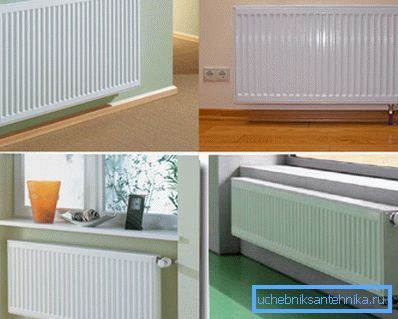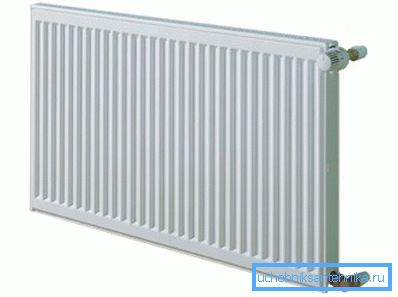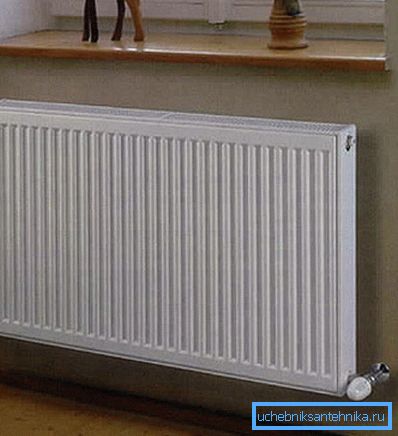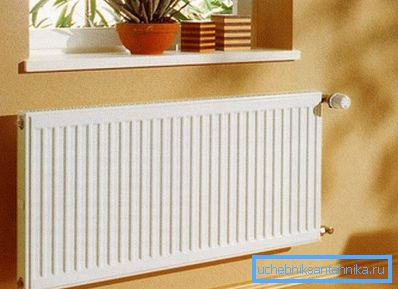What is the steel radiator heating kermi and how they are
Making a decision to create a heating system in a house, a large role is given not only to the heat source, but also to the appliances that should give it. In the construction market, one can come across various types of radiators, which differ from one another in the material of manufacture, shape and design. Today our task is to tell readers about steel devices Kermi (Germany).

You will learn about their design, features and appearance, so that before you buy them you have the most complete information about the product. We will also tell you about the pros and cons of these space heating devices.
Design features
Steel radiators of this type are offered to consumers in two versions:
| With a cavity |
|
| Coil | This radiator of heating of Kermi represents a design from the bent steel pipes. They are then pressed on the plate, with which it is possible to increase the total area of the radiator, increasing the efficiency of heat transfer. |
The price of any device depends on its size.

Features:
- The body of the product is made of low carbon steel. He is not afraid of corrosive processes and durable in operation.
- The face of the material is a phosphated surface, covered with powder enamel. It dries at high temperature, which turns it into a uniform layer. This allows you to reliably protect the heating devices of the company from negative environmental factors.
- Most often, a Kermi heating radiator is offered in white color, however, at the request of the customer, the palette may vary.

Positive properties of products
In the development of any product, and even more so heating radiators, are guided by its main purpose.
Below we describe the positive aspects of the device that should be considered when choosing it:
- Durability, as Kermi radiators are made of high-grade steel.
- They do not react to pressure drops in central heating pipes, which can often be observed during their operation.
- The allowable pressure for these devices is on average 10 atm. On the test bench, the products withstood a 14-bar water hammer.
- The strict and modern design of steel heating devices “Kermi” makes it possible to fit equipment into almost any interior.
Tip: you can control the heating system with additional temperature sensors installed on radiators.
- Special regulators allow you to control the heating temperature of each device separately and provide an opportunity to completely shut off the flow of coolant. Thus, it is possible to significantly save the consumed thermal energy.
- You can connect Kermi steel radiators to any type of pipe, including from:
- metal plastics;
- become;
- polypropylene;
- of stainless steel.

Assembly process
Connecting the batteries depends on the model, most often the installation is carried out using the lower or side option. This allows you to significantly facilitate the installation process with your own hands, since no additional pipelines are required.
The devices are supplied in a complete set, so that you will not need to purchase additional mounts and parts.
Tip: if you doubt your plumbing skills, contact a specialist in order not to have problems with the operation of the device in the future.
Otherwise, if the rules of installation and technical instruction were violated, no one can guarantee you uninterrupted operation of the heater in the time specified by the manufacturer.

Installation of steel radiators "Kermi" is allowed in any heating system:
- "Leningradke" or one pipe;
- two-pipe - with feed and return;
- with forced circulation of the coolant;
- with the natural movement of the coolant.
The product is able, on average, to withstand the temperature of a fluid circulating through it up to 140? С. The recommended temperature is 65-70? С; in this case, the radiators will not dry the air and will be able to create an optimal microclimate in the room. On this basis, you have almost twice the margin of safety in terms of temperature and 30% in case of possible pressure drops in the system.
Negative aspects of devices
Despite a lot of positive things, the company's radiators have drawbacks:
- Corrosion - the most significant minus, although such processes begin to occur only after the coolant is drained from the device. Experts say that after 15 days, minor damage is already visible on the inner surface of the products.
- The sensitivity of the material to low quality coolant, which is used in centralized heating.

Conclusion
Strong, reliable, durable, beautiful appearance, effective in operation - all this can be said about the steel radiators "Kermi". They fit perfectly into the interior, can create the necessary microclimate in the room, thanks to the regulating devices.
Installation of products will not cause any special difficulties even for a professional plumber. When choosing, consider the positive and negative sides of the heaters. The video in the article will help you find additional information on this topic.